[CODE] Camera settings
-
Well they can all be converted to strings, right? And then turned back into floats or true/false type values if you bring them back into SU. Am I missing something here? This is the answer to the question, unless I'm misunderstanding the question.
-
@chris fullmer said:
Well they can all be converted to strings, right? And then turned back into floats or true/false type values if you bring them back into SU. Am I missing something here? This is the answer to the question, unless I'm misunderstanding the question.
I see. I have never done anything with the camera coding, that is why I asked the question in advance of starting that work. I am now doing exposing layers that have mixed groponents/dimensions/text, so perhaps I was not concentrating properly. But I hope to start/finish on the camera in a couple of days, so all the possibilities are most welcome - thanks Chris
-
I have a script I'm working on where I'm trying to iterate through scenes/pages and look for faces parallel to the camera for each scene. I have the code to iterate through faces and test to see if parallel to the camera, but I could find a way to grab the camera for other scenes to iterate my tests across all scenes.
I suppose I can change to each scene and then get current camera view, but I would think I should be able to grab the camera from a scene without having to change to that scene. Keep in mind, I don't know the scene names.
edited content below
OK, I solved my problem, here is a piece of the code.
# draft script - David Goldwasser # find faces parallel to camera and draw lines back to camera model = Sketchup.active_model entities = model.active_entities pages = model.pages faces = [] entities.each do |n| faces.push n if n.is_a? Sketchup;;Face end pages.each do |page| camera = page.camera eye = camera.eye faces.each do |face| status = camera.direction.parallel? face.normal if status then edges = face.edges edges.each do |edge| pts = [] pts [0] = eye pts[1] = edge.start.position pts[2] = edge.end.position face = entities.add_face pts end else end end endThe pages.each do is where I was having problems before. I was actually switching to that page and then getting current view, camera etc. But the animation was causing problems, so I had to have a dummy UI.messagebox to get it to behave. Now I don't and it is much cleaner.
So I have an edges.each nested in a faces.each, nested in a pages.each. My indentation for isn't so clear when previewed here.
-
When I regenerate a scene without zoom extents the scale is very small. Zoom extents would be OK if I didn't want to capture the original zoom that produced close ups for example. But I think it important, so if anyone can help I would be grateful.
Thanks
-
I'm not quite sure what you mean. Zoom extents is a separate matter, not really related to scenes, except that it can change the camera position.
So do you want to use zoom extents? Or not use it? Or do you want to match the scene camera settings precisely? Or do you want to get the scene camera, zoom extents, then update the scene camera to reflect the new camera? Or probably something entirely different that I'm missing?

Chris
-
@chris fullmer said:
... Or do you want to match the scene camera settings precisely?
Yes I want to match them precisely. I just used zoom extents because the display was ridiculously tiny. Do you have have an idea why?
When zooming you change the camera position or something else? I didn't use new camera but active camera, perhaps that is what is wrong. All the scenes are reconstructed in the one Nameset tab by showing/hiding components (only layers for dims and notes).
Thanks
-
So to further understand now: You have an existing model with scenes in it. Then you iterate otver the scenes and get all the cameras and save the camera settings. Then you want to use your script to re-create the cameras from the scenes. Is that the idea?
If so, then what your script does should not differ from the cameras in the scenes. so if the camera is zoomed way out in the scene, then that is what your script should make too. IS this not currently what you are achieving?
If that is the case, then it sounds like somehow you are missing something in the camera settings when you extract them from the scenes. And the field of view might be my guess. Are you checking or setting the Field of View at any point in your script? I think ideall you would check the FOV of the scene camera and then st your camera to match when you create your camera object.
Chris
-
@chris fullmer said:
So to further understand now: You have an existing model with scenes in it. Then you iterate otver the scenes and get all the cameras and save the camera settings. Then you want to use your script to re-create the cameras from the scenes. Is that the idea?
Yes - maybe recreate views of the model is a better term.
@unknownuser said:
If so, then what your script does should not differ from the cameras in the scenes. so if the camera is zoomed way out in the scene, then that is what your script should make too. IS this not currently what you are achieving?
Please see pixs and code.
@unknownuser said:
If that is the case, then it sounds like somehow you are missing something in the camera settings when you extract them from the scenes. And the field of view might be my guess. Are you checking or setting the Field of View at any point in your script? I think ideall you would check the FOV of the scene camera and then st your camera to match when you create your camera object.
Please have a look at the code. From the console and js output it seems the fov does not change. Perhaps I have made the error there.
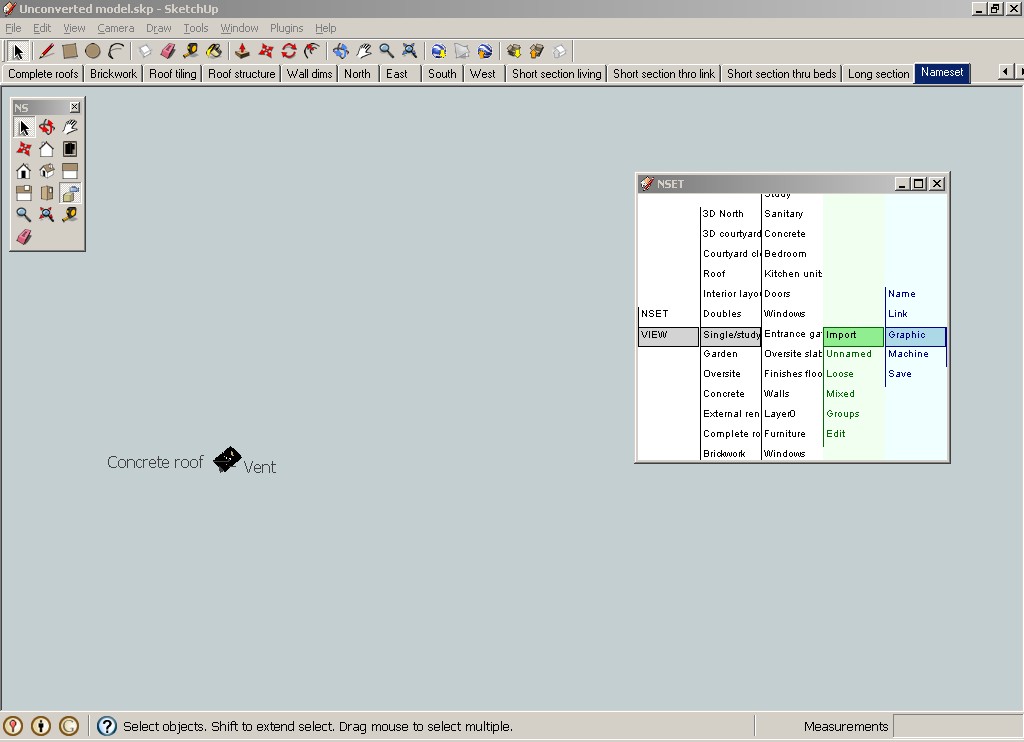
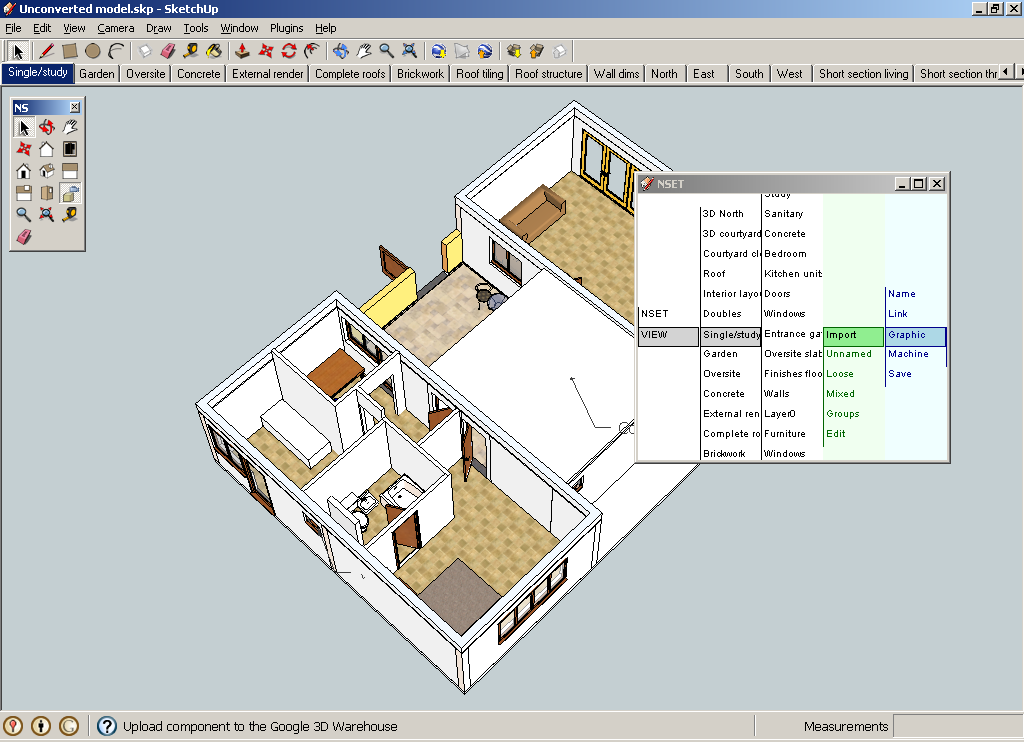
-
... and the non perspective views are the same ...
-
I can't parse your code very quickly Chris. Especially once it goes out to js, I'm lost. But it looks like you are doing the right thing by getting the fov for the perspective cameras. But somewhere in there, something is getting messed up. If you get the values correctly and apply them back correctly, the cameras will match 100%. There should be no need to do a zoom extents. So it is clear that somewhere the values are not coming through correctly. I would do some solid value testing. Output all the values before they go to js, then output them again as you recreate the camera. See if they differe at all.
Also, if you could make a model with a scene, then run your script on it and recreate that camera, then create a new scene that uses your camera info it might be easier to compare the settings of the 2 cameras - the original and your recreation.
Chris
-
Thanks for all your effort Chris. Just by posting those pix
**.mm**came to mind ... errgh ... but somehow oddly satisfying. First go seems to work but still not quite it. You know when the French gave you the Statue of Liberty, it would have been nice if you had taken up their metric system.Tally ho!
-
Hehe, yeah sorry about that imperial vs. metric thing. I hope you're able to pin down the problems!
Chris
-
@chrisglasier said:
Yes guess what - fov is in mm by default!
Here's a kind of victory pic.
I amended the previous code in case anyone is thinking of doing something similarly lunatic.Cheers.
hi Chris,
I can't get the feb016.avi to run on any player, I'm on a Mac but don't normally have problems with .avi
can you out-put a quicktime.mov as well? Is it the same video that's up on youtube?
I'm very interested in your approach and although I'm only just starting to learn coding, I'd like to integrate namespace conventions into my efforts right from the start.john
-
@unknownuser said:
Is it the same video that's up on youtube?
Yes. You could also look at my old website (button on left).
Now I'm off to the real movies for a while.
Interested in your interest.
-
Yes guess what - fov is in mm by default!
Here's a kind of victory pic.
I amended the previous code in case anyone is thinking of doing something similarly lunatic.Cheers.
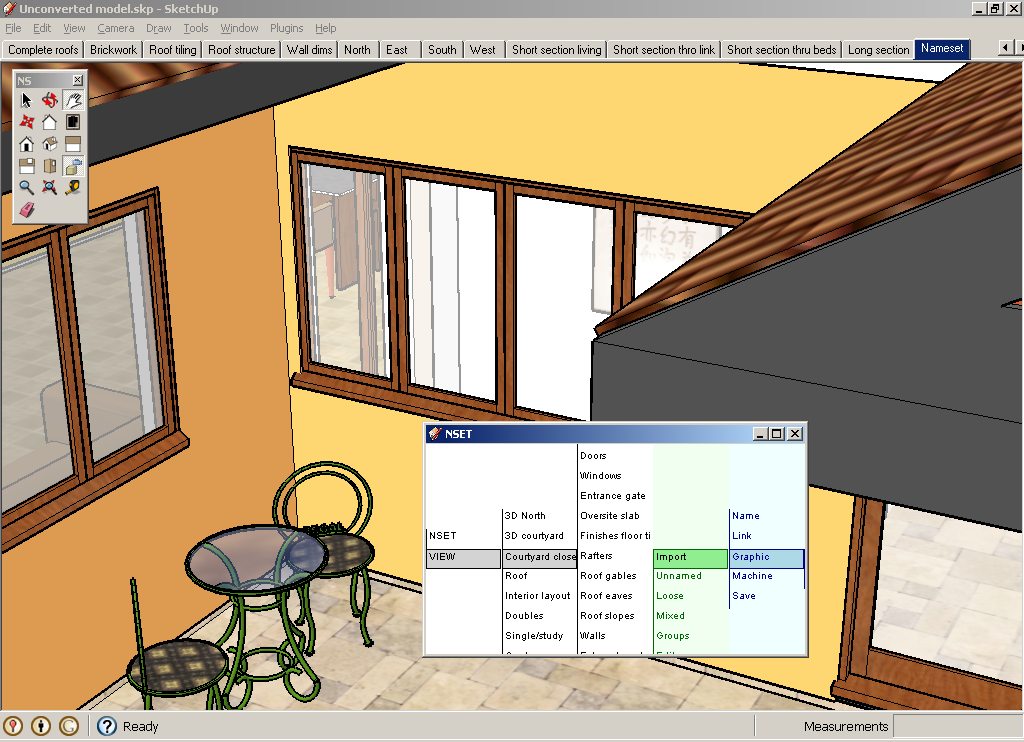
-
A couple of odd things I just discovered when doing something else is that whereas the perspectives are spot on the standard views are unstable. The top/plan views for example get some 164% bigger when imported. See pixs:
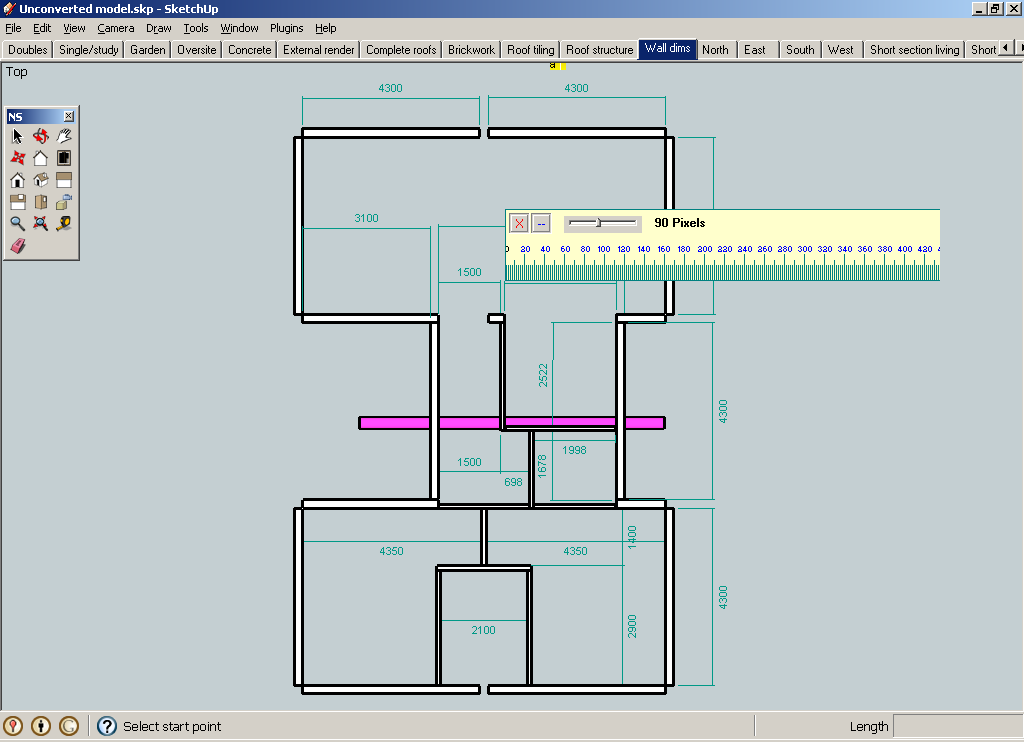

The other is that I.mm'd the vector3ds for up. I changed them but it didn't make any difference. (Obviously I don't understand this stuff well enough.) -
Thanks for your help.
[flash=600,432:21eq7727]http://www.youtube.com/v/6h6m_xr5IYA&hl=en_US&fs=1&[/flash:21eq7727]
For anyone interested here are extracts from the rather clunky code I ended up to support this v quick video hinting at the potential.
Ruby extractor:
pages = model.pages layers = model.layers styles = model.styles @parray =[] pages.each do |page| model.pages.selected_page = page cam = page.camera name = page.name pl = [] page.layers.each do |layer| pl.push(layer.name) end pl = pl.join(",") st = page.style st = st.name pts = [cam.eye, cam.target, cam.up] per = cam.perspective? if(cam.perspective?) fov = cam.fov sub = [pts,per,fov] else sub = [pts,per] end sub = sub.join("yy") entry = [name,pl,st,sub] @parray.push(entry.join("xx"))JS converter
p = ret[3].split(";"); pages = []; for (a = 0; a < p.length; a += 1){ p[a] = p[a].split("xx"); lgth = fLength(nset); lab = lgth.toString(); o = {}; o.Type = "Scene"; o.Genus = "New"; o.Name = p[a][0]; o.Backlink = []; o.Backlink.push(sRoot); o.Hidden = []; nset[lab] = o; nset[sRoot].Forelink.push(lab); pages.push(lab); nset[lab].Forelink = []; //mark hidden layers //alert(p[a]) pp = p[a][1].split(","); for (c = 0; c < pp.length; c += 1){ for (d = 0; d < combo.length; d += 1){ if(pp[c] === nset[combo[d]].Name){ nset[combo[d]].Filter = 1; } } } for (d = 0; d < combo.length; d += 1){ nset[combo[d]].Backlink = []; if(!nset[combo[d]].Filter){ nset[lab].Forelink.push(combo[d].toString()); nset[combo[d]].Backlink.push(lab); } else{ delete nset[combo[d]].Filter; } } //name,pl,st,camry nset[lab].Style = p[a][2]; nset[lab].Camera = p[a][3]; }JS scene call
function fScenes(){ var cell,nt,node,name,kids,dn,cm,genus,cmps; cell = document.getElementById("ScenesOn") nt = config.nametrail; node = nt[nt.length-1][0]; type = nset[node].Type; if(type === "Scene"){ name = nset[node].Name; kids = nset[node].Forelink; dn = []; cm = []; for(a = 0; a <kids.length; a += 1){ genus = nset[kids[a]].Genus if(genus === "Dimension" || genus === "Notes"){ dn.push(nset[kids[a]].Name); continue; } dn.push(nset[kids[a]].Name); cmps = nset[kids[a]].Forelink; for(b = 0; b <cmps.length; b += 1){ cm.push(nset[cmps[b]].Index); } } name = nset[node].Name; style = nset[node].Style; rec = nset[node].Camera.split("yy"); cam = []; //eye,target,up for(a=0; a < 3; a += 1){ cam.push(rec[a].slice(1,-1)); } cam.push(rec[3]) if(rec[3]){ cam.push(rec[4]); } data = [name,dn.join(","),cm.join(","),style,cam]; document.getElementById("trans").value = data.join("|"); window.location = "skp;scene"; } }Ruby callback
@dlg.add_action_callback("scene") {|d, p| a = @dlg.get_element_value("trans") a = a.split("|") name = a[0].split(",") lyrs = a[1].split(",") cmps = a[2].split(",") sty = a[3].to_s cam = a[4].split(",") model = Sketchup.active_model entities = model.entities entities.each do |entity| if entity.class == Sketchup;;ComponentInstance || entity.class == Sketchup;;Group entity.visible = false end end cmps.each do |c| a = Integer(c) #p entities[a].name entities[a].visible = true end layers = model.layers layers.each do |layer| layer.visible = false end lyrs.each do |lyr| layers[lyr].visible = true; #p layers[lyr].name end pages = model.pages styles = model.styles page = pages["Nameset"] styles.selected_style= styles[sty] page.use_style = styles.selected_style eye = Geom;;Point3d.new [Float(cam[0]).mm, Float(cam[1]).mm, Float(cam[2]).mm] target = Geom;;Point3d.new [Float(cam[3]).mm, Float(cam[4]).mm, Float(cam[5]).mm] up = Geom;;Vector3d.new [Float(cam[6]), Float(cam[7]), Float(cam[8])] camera = model.active_view.camera camera.set(eye,target,up) if cam[9] == "true" camera.perspective = true else camera.perspective = false end if camera.perspective? camera.fov = Float(cam[10]) end }It seems to work OK but I don't like the zoom extents (I'm working on that).
As they say in the gallery ... C&C welcome.
Edit 15 Feb: Changed code in callback to match post post revelations
-
And here's the matrix returns for one component in the original and recreated view.
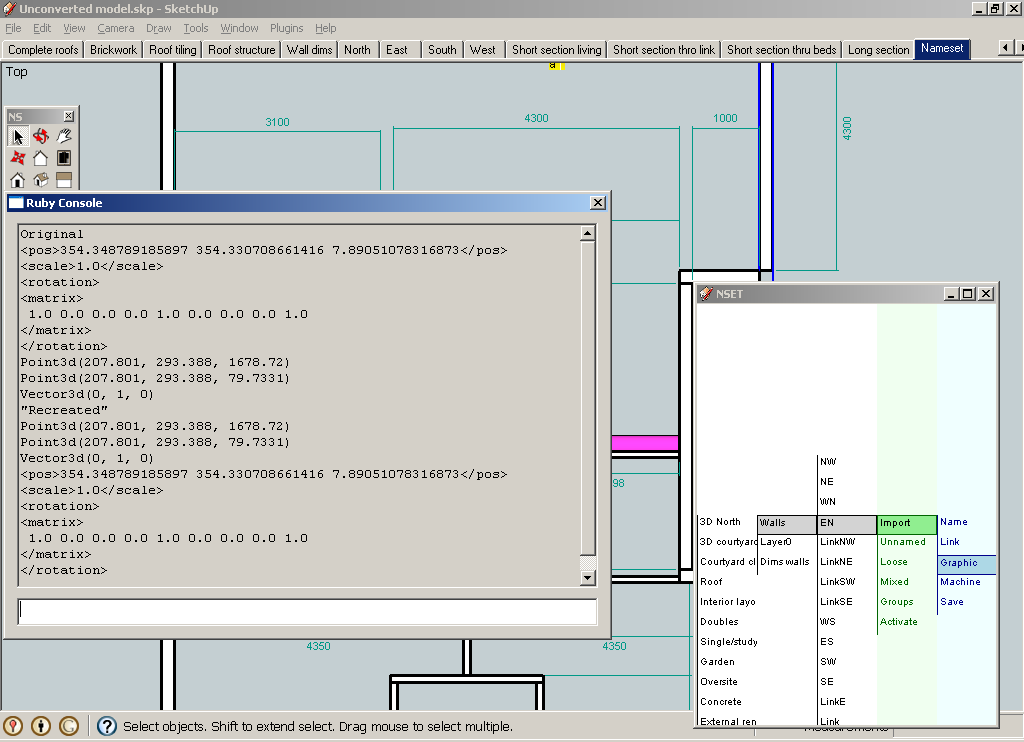
Advertisement







